Grass jelly, also known as Cincau in Southeast Asia, is a popular dessert and beverage ingredient in many Asian countries, including China, Taiwan, Malaysia, and Indonesia.
It is a refreshing and delicious treat that can be enjoyed on its own or combined with other ingredients, such as fruits, coconut milk, or syrup. Apart from its unique taste and texture, grass jelly also boasts several health benefits.
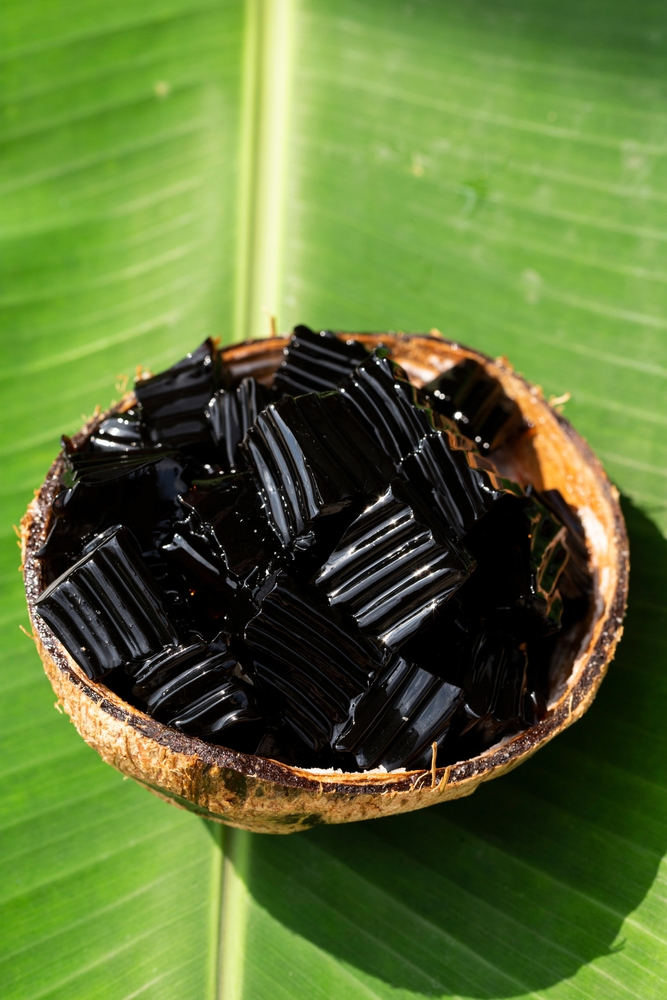
Grass Jelly Recipe
Grass jelly is made from the leaves and stems of the Mesona chinensis plant. The plant is boiled, and the resulting liquid is cooled until it solidifies into a jelly-like substance. Here is a simple grass jelly recipe that you can make at home:
Ingredients:
- 1 packet of grass jelly powder (about 0.28 to 0.35 ounces)
- 2 cups of water
- 1/4 cup of sugar (or to taste)
- 1/4 teaspoon of salt
- 4 cups or glasses
Instructions:
- In a pot, bring 2 cups of water to a boil.
- While waiting for the water to boil, mix the grass jelly powder, sugar, and salt in a bowl. (Follow package instructions)
- Once the water boils, turn off the heat and pour the grass jelly mixture into the pot.
- Stir the mixture until the powder is completely dissolved.
- Pour the hot grass jelly mixture into the cups or glasses, leaving some space at the top for the grass jelly to solidify.
- Let the grass jelly cool to room temperature, then refrigerate for at least 2-3 hours or until it solidifies.
- Cut the solidified grass jelly into cubes or desired shapes and serve chilled. Enjoy!
You can also make your own grass jelly by using the mesona leaves. This is a longer process but worth it!
- 1/2 cup of dried Mesona chinensis leaves
- 2 cups of water
- 1/2 cup of dark brown sugar (or to taste)
- 1/4 teaspoon of salt
- 1 tablespoon of corn starch
Instructions:
- Soak the dried Mesona chinensis leaves in water for at least 30 minutes
- Rinse the leaves or powder thoroughly.
- Boil 2 cups of water in a pot and add the Mesona chinensis leaves
- Reduce to low heat and simmer for 20-30 minutes.
- Strain the grass jelly liquid into a separate container and discard the leaves
- Add sugar and salt to the liquid and stir until dissolved.
- Mix cornstarch with a tablespoon of water and add to the liquid, stirring continuously.
- Pour the liquid into a container and refrigerate for 2-3 hours or until solidified to a jelly-like texture.
- Cut the solidified grass jelly into small cubes or desired shapes.
Pro Cooking tips for making Cincau
- Use hot water to dissolve the grass jelly powder: To dissolve the grass jelly powder, it is best to use hot water instead of cold water. This will help the powder dissolve more quickly and evenly.
- Use a whisk or blender to mix the powder: A whisk or blender can help mix the grass jelly powder more thoroughly, ensuring that there are no lumps in the mixture.
- Let the grass jelly cool before using it: Once the grass jelly mixture has been made, let it cool to room temperature before using it in your recipe. This will help the mixture set properly and prevent it from becoming too runny.
- Don’t overcook the grass jelly: Grass jelly should not be overcooked, as this can cause it to become tough and chewy. It is important to follow the cooking instructions carefully and remove the grass jelly from the heat as soon as it has set.
- Add flavorings to the grass jelly: Grass jelly has a mild flavor, so it is often combined with other ingredients to add flavor. Try adding fruit, sugar, condensed milk, or coconut milk to the grass jelly to give it a more complex flavor.
- Cut the grass jelly into small pieces: When using grass jelly as a topping or ingredient in your recipe, it is best to cut it into small pieces. This will make it easier to incorporate into your dish and ensure that each bite has a good balance of flavors and textures.
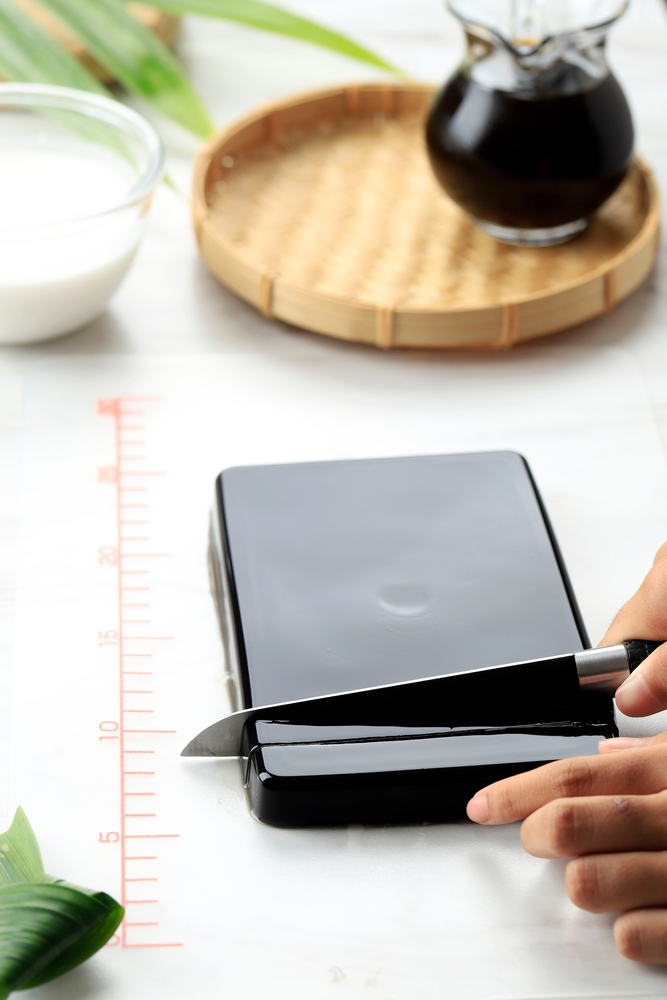
Why you’ll love this herbal dessert
- Easy to make: This recipe is quick and simple to make, and requires only a few ingredients. It’s a great option for those who are short on time or new to cooking with grass jelly.
- Healthy: Grass jelly is a low-calorie and low-fat ingredient that is high in antioxidants and may have several health benefits. It’s a great option for those who want to enjoy a sweet treat without consuming a lot of sugar or unhealthy fats.
- Versatile: Grass jelly can be used in a variety of dishes, from drinks to desserts. This recipe allows you to make a batch of grass jelly that can be used in a variety of different recipes.
- Vegan and vegetarian-friendly: Grass jelly is a vegan and vegetarian-friendly ingredient that can be used in a variety of recipes. This recipe is a great option for those who follow a vegan or vegetarian diet.
- Delicious: Grass jelly has a unique texture and flavor that is both refreshing and satisfying. This recipe produces a grass jelly that is smooth and soft, making it a great addition to drinks, desserts, and other recipes.
What is grass jelly (Cincau) made from?
Grass jelly, also known as leaf jelly or cincau in Southeast Asia, is made from the leaves and stalks of a plant called Mesona chinensis, which is native to China and Taiwan. The plant is boiled and then the resulting liquid is cooled and allowed to solidify into a jelly-like substance.
The jelly is then cut into cubes or other desired shapes and can be served on its own or mixed with other ingredients to make various desserts and beverages. The flavor of grass jelly is mild and slightly herbaceous, with a texture that is smooth and slightly gelatinous. Grass jelly is a popular ingredient in many Asian cuisines and is valued for its unique taste and various health benefits.
Health Benefits of Grass Jelly
- Aids Digestion: Grass jelly is rich in dietary fiber, which helps promote healthy digestion. Fiber aids in maintaining bowel regularity, preventing constipation, and reducing the risk of digestive disorders like irritable bowel syndrome (IBS).
- Lowers Cholesterol: Grass jelly is also an excellent source of antioxidants, which can help reduce the levels of bad cholesterol (LDL) in the body. A study found that consuming grass jelly regularly can lower LDL levels by up to 20%.
- Regulates Blood Sugar: Grass jelly has a low glycemic index, meaning it can help regulate blood sugar levels. This makes it an ideal dessert or beverage for people with diabetes or those trying to manage their blood sugar levels.
- Rich in Minerals: Grass jelly is an excellent source of minerals like calcium, iron, and potassium. Calcium is essential for strong bones and teeth, while iron is vital for the production of red blood cells. Potassium helps regulate blood pressure and maintain proper fluid balance in the body.
- Hydrating: Grass jelly is high in water content and can help keep the body hydrated. Consuming grass jelly regularly can help prevent dehydration, which can lead to headaches, fatigue, and other health issues.
Grass jelly is not only a tasty dessert and beverage ingredient, but it also offers several health benefits. The grass jelly recipe is easy to make and can be enjoyed in various ways.
Incorporating grass jelly into your diet can help promote healthy digestion, lower cholesterol, regulate blood sugar, and provide essential minerals to the body.
What does grass jelly taste like?
Grass jelly has a mildly bitter taste taste with a hint of herbal flavor. Some people describe the taste as similar to that of green tea or a lightly sweetened coffee.
The texture of grass jelly is smooth and slightly gelatinous, making it a popular ingredient in desserts and drinks in many Southeast Asian countries.
The taste of grass jelly is unique and refreshing, and it’s a popular ingredient in many Asian cuisines.
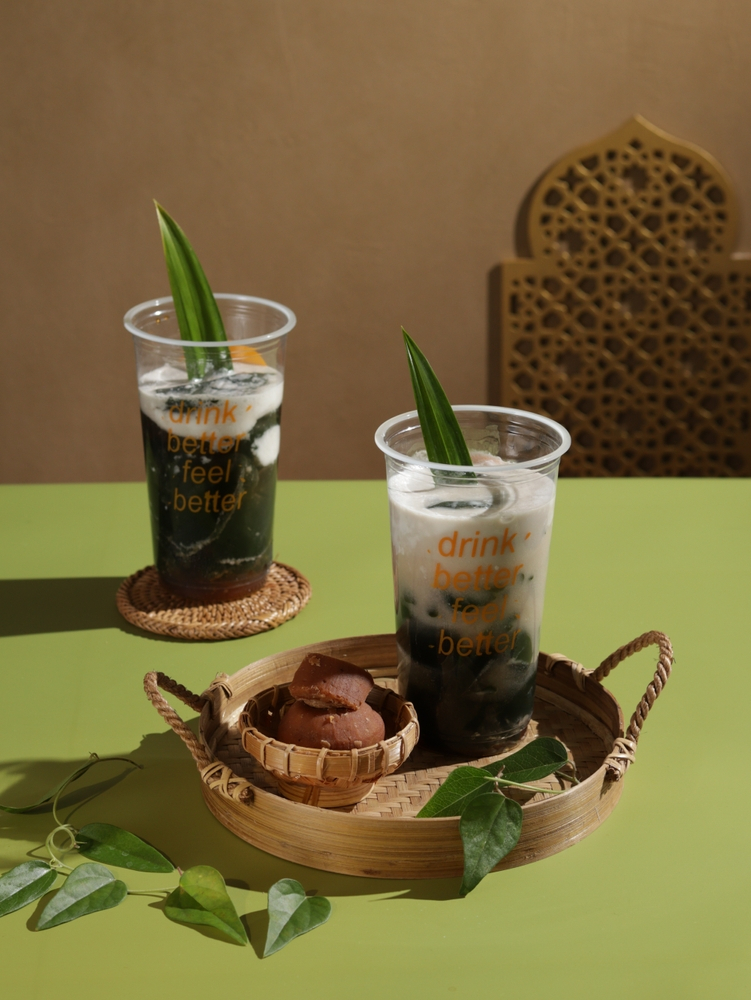
What is grass jelly used for?
- Grass jelly drink: Grass jelly can be mixed with water, sugar, and ice cubes to make a refreshing drink on a hot day.
- Grass jelly dessert: Grass jelly can be added to other ingredients to make various desserts, such as grass jelly ice cream, grass jelly pudding, grass jelly with fruits, and grass jelly with coconut milk.
- Grass jelly topping: Grass jelly can be used as a topping for shaved ice or sweet soups, adding flavor and texture to the dish.
- Health benefits: Grass jelly is believed to have various health benefits, such as improving digestion, reducing inflammation, and lowering blood pressure. It’s also a popular ingredient in traditional Chinese medicine.
Ways to use grass jelly
- Grass jelly salad: Mix grass jelly with fruits such as strawberries, mangoes, and kiwi for a refreshing salad. You can also add whipped cream or yogurt for a creamy texture.
- Grass jelly smoothie: Blend grass jelly with your favorite fresh fruit and milk for a healthy and filling smoothie.
- Grass jelly cake: Use grass jelly as a filling or topping for cakes, such as angel food cake or chiffon cake for a sweet dessert.
- Grass jelly tea: Add the herbal jelly to bubble tea, milk tea or cold coffee for a unique and refreshing drink.
- Grass jelly milkshake: Blend grass jelly with ice cream and milk for a creamy and delicious milkshake.
- Grass jelly parfait: Layer grass jelly cubes with yogurt, fruit, and granola for a healthy and filling breakfast or snack.
- Grass jelly mochi: Wrap grass jelly cubes in mochi (sweet glutinous rice cake) for a unique and tasty dessert.
- Grass jelly popsicles: Freeze grass jelly cubes mixed with fruit juice or coconut milk in popsicle molds for a refreshing and healthy treat to enjoy on hot summer days
- Grass jelly bubble tea: Mix grass jelly cubes with bubble tea for a fun and refreshing drink on a nice sunny day.
- Grass jelly soup: Add grass jelly cubes to a clear soup, such as chicken broth or vegetable broth, for added texture and flavor.
- Grass jelly sushi: Use grass jelly as a filling for sushi rolls, along with other ingredients such as avocado, cucumber, and crab meat.

Substitutes for grass jelly
- Agar agar: Agar agar is a vegetarian gelatin substitute that can be used in place of grass jelly. It has a similar texture and can be used in desserts and drinks.
- Gelatin: If you don’t mind using animal products, you can use gelatin as a substitute for grass jelly. It has a similar texture and can be used in desserts and drinks.
- Chia seeds: Chia seeds can be soaked in water or milk to create a gel-like texture similar to grass jelly. However, they have a slightly different taste and texture compared to grass jelly.
- Tapioca pearls: Tapioca pearls are often used in bubble tea and have a similar texture to grass jelly. However, they have a different taste and are not as sweet as grass jelly.
- Konjac jelly: Konjac jelly is a popular ingredient in Japanese cuisine and has a similar texture to grass jelly. It is often used in desserts and drinks and can be found in Asian grocery stores.
Is Glass Jelly the same as Boba?
Grass jelly has a gelatinous texture and a mild, slightly bitter taste. It is typically used as a topping or ingredient in desserts, such as shaved ice, grass jelly with sweet syrup, or grass jelly mixed with fruit.
Boba, on the other hand, has a chewy texture and a mild, sweet flavor. It is often added to milk tea or fruit-based drinks as a topping or mixed in with the drink itself.
You may find both in the same type of beverage or dessert but they are not the same thing.
Where to find glass jelly plant, canned grass jelly, and powdered grass jelly
Grass jelly plant is native to Southeast Asia, and it may be difficult to find fresh leaves outside of this region. However, dried grass jelly leaves and grass jelly powder and the canned version can often be found in Asian grocery stores or online.
Does black grass jelly come in other colors?
Grass jelly is typically dark or black in color. The dark color comes from the leaves of the Platostoma palustre plant, which are used to make the black jelly. The leaves are boiled to extract the juice, which is then combined with starch and other ingredients to make the jelly.
However, there are some variations of grass jelly that are not black. For example, there is a type of grass jelly called “white grass jelly” or “green grass jelly” that is made from different plants and has a different color. Some manufacturers also add coloring or flavorings to the jelly to create different flavors/varieties.
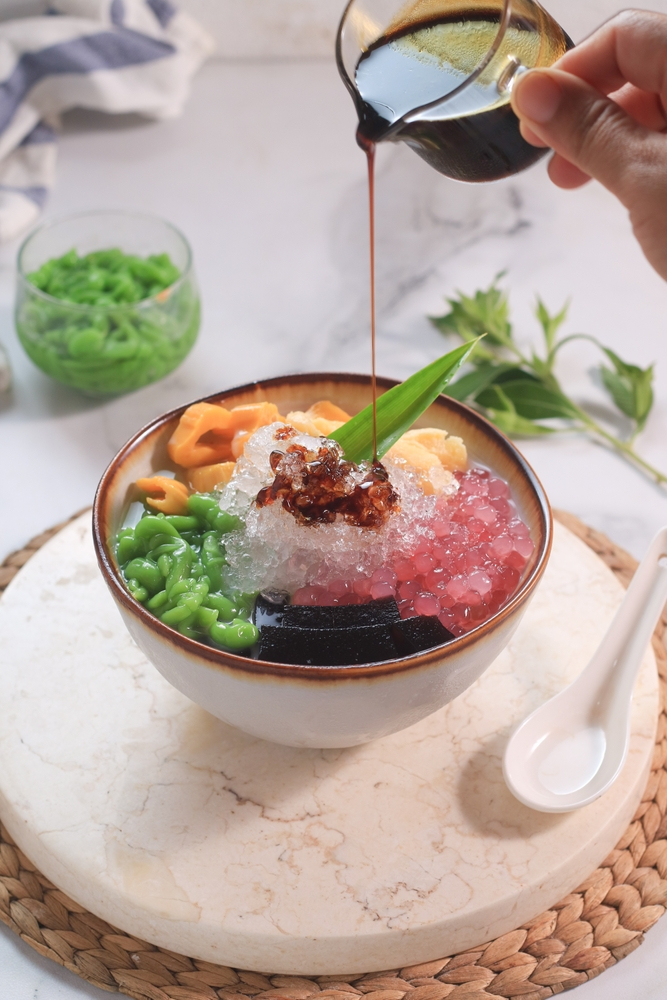
How to store grass jelly
- Allow the grass jelly to cool to room temperature.
- Place the grass jelly in an airtight container.
- Seal the container and place it in the refrigerator.
- Use the grass jelly within five days.
If you have made a large batch of grass jelly and want to store it for a longer period, you can freeze it. Here’s how:
- Cut the grass jelly into small pieces.
- Place the pieces of grass jelly in an airtight container or freezer bag.
- Seal the container or bag, removing as much air as possible.
- Label the container with the date and place it in the freezer.
- Grass jelly can be stored in the freezer for up to two months.
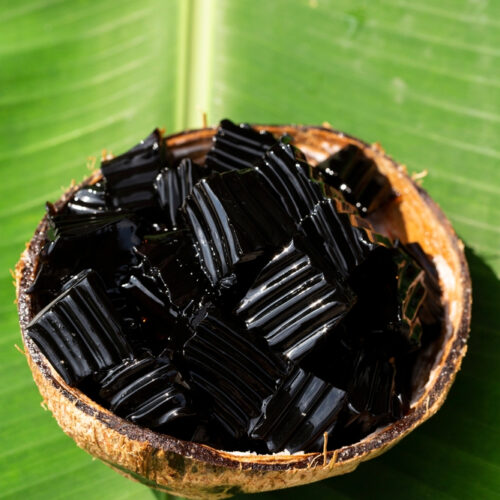
Grass Jelly (Cincau) Recipe [Easy Chinese Dessert]
Ingredients
- 1 packet grass jelly powder
- 2 cups water
- 1/4 cup sugar
- 1/4 tsp salt optional
- 4 glasses to pour jelly into
Instructions
- In a pot, bring 2 cups of water to a boil.
- While waiting for the water to boil, mix the grass jelly powder, sugar, and salt in a bowl.
- Once the water boils, turn off the heat and pour the grass jelly mixture into the pot. Stir the mixture until the powder is completely dissolved
- Pour the hot grass jelly mixture into the cups or glasses, leaving some space at the top for the grass jelly to solidify
- Let the grass jelly cool to room temperature, then refrigerate for at least 2-3 hours or until it solidifies
- Cut the solidified grass jelly into cubes or desired shapes and serve chilled. Enjoy!
